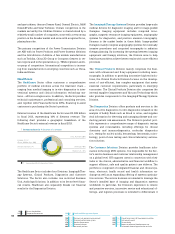Siemens 2013 Annual Report Download - page 170
Download and view the complete annual report
Please find page 170 of the 2013 Siemens annual report below. You can navigate through the pages in the report by either clicking on the pages listed below, or by using the keyword search tool below to find specific information within the annual report.
92 A. To our Shareholders
117 B. Corporate Governance 155 C. Combined Management Report
156 C. Business and economic environment
173 C. Financial performance system
179 C. Results of operations
192 C. Financial position
204 C. Net assets position
207 C. Overall assessment of the economic position
209 C. Subsequent events
210 C. Sustainability
227 C. Report on expected developments and
associated material opportunities and risks
Overall, the market for the Infrastructure & Cities Sector grew
moderately in fiscal . While markets served by the Trans-
portation & Logistics Business showed a steady recovery
including tenders for a number of large projects, markets for
the Power Grid Solutions & Products Business and the Building
Technologies Division showed little or no growth. Customers
cut spending in both these markets, and also delayed project
awards in the power grid solutions market.
In fiscal , markets served by our Transportation & Logis-
tics Business showed a steady recovery from the weak envi-
ronment a year earlier. Moderate growth was driven by large
contract awards, particularly in the U.K. and the Middle East.
Furthermore, market growth was positively influenced by
demand from major cities, which continued to invest in public
transport systems. On a regional basis, the highest growth
rates came from Asia, Australia, driven by strong demand from
China. Demand in the Americas was also clearly up year-over-
year. Within Europe, market development was divided between
northwestern countries, which kept their public transport
investments stable and southern countries, which held back
investments as part of wider austerity programs. As a result,
markets in the Europe, C.I.S., Africa, Middle East region
showed the lowest growth of all regions.
Demand in the markets served by our Power Grid Solutions &
Products Business remained weak across all regions in fiscal
. Higher demand from industrial customers was more
than offset by delayed project awards and reduced grid invest-
ments by utility companies. Reduced investments were partic-
ularly evident in southern Europe. Investment sentiment was
also affected by uncertainty in the regulatory environment,
such as in Germany which is undertaking a massive shift to
renewable energy (“Energiewende”). Demand in the U.S.
showed signs of recovery in the industry and construction cat-
egories, but investment in power grid solutions by utilities
remained weak.
Markets served by our Building Technologies Division held
steady year-over-year as customers were hesitant to increase
investments. Markets in the solution business suffered from
ongoing price pressure due mainly to aggressive pricing by
system houses and large providers of building technologies
solutions. On a regional basis, slight market growth in Asia,
Australia and the Americas was largely offset by a slight de-
cline in Europe, C.I.S., Africa, Middle East.
C.. Strategy
C... GLOBAL MEGATRENDS
Global megatrends are long-term developments that are ex-
pected to have an impact on all humanity. We at Siemens
view demographic change, urbanization, climate change and
globalization as megatrends that will drive global demand in
coming decades. We have aligned our strategy with these
developments and accordingly have organized our business
into four Sectors: Energy, Healthcare, Industry, and Infrastruc-
ture & Cities.
Demographic change includes two major trends: the world’s
population continues to grow steadily, and it continues to get
older. Together, these two trends will challenge the ability of
future healthcare systems to make healthcare available to
everyone. Urbanization refers to the growing number of
densely-populated metropolitan centers around the world.
This trend intensifies the already strong demand for sustain-
able and energy-efficient infrastructures for buildings, trans-
portation systems, energy and water. We view climate change
as a fact and that reducing greenhouse gas emissions is vital
to counteract the increasingly drastic effects on our eco-
system. There is a strong need for innovative technologies to
increase efficiency and reduce the emissions related to energy
generation and consumption. Globalization refers to the
increasing integration of the world’s economies, politics, cul-
ture and other areas of life. Globalization leads to increased
competitive pressure and demand for economical, timely-to-
market, high-quality products and solutions.
C... STRATEGY OF THE SIEMENS GROUP
Our vision is to be a pioneer in
> energy efficiency,
> industrial productivity,
> next-generation healthcare, and
> intelligent infrastructure solutions.
Our company strategy guides us in turning our vision into real-
ity. We are aiming to be a market and technology leader in our
businesses, based on our values – to be responsible, excel-
lent and innovative. We believe that this will position us to
achieve sustainable, profitable growth and thereby continually
increase our company value. We intend to profit from the
mega trends described above.
























